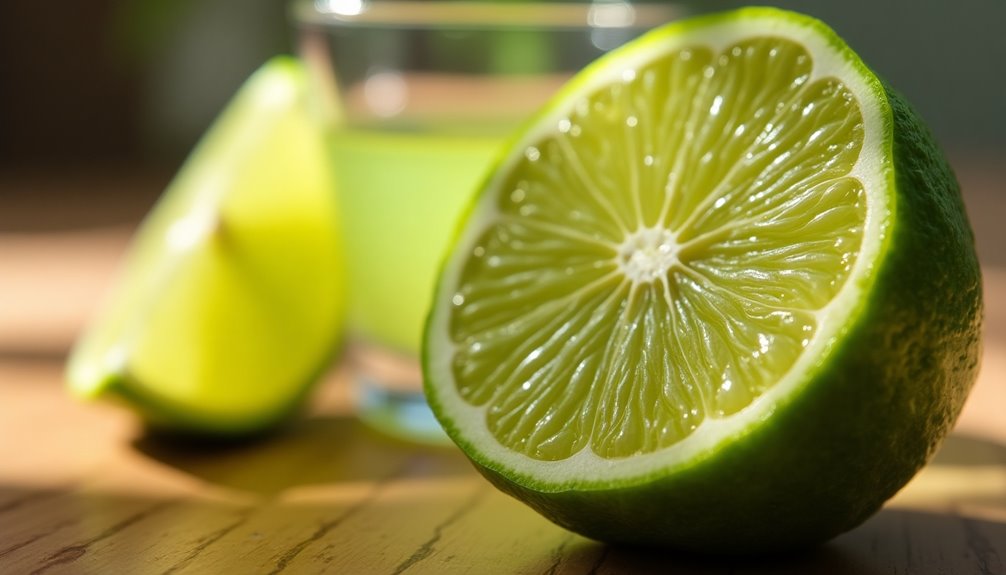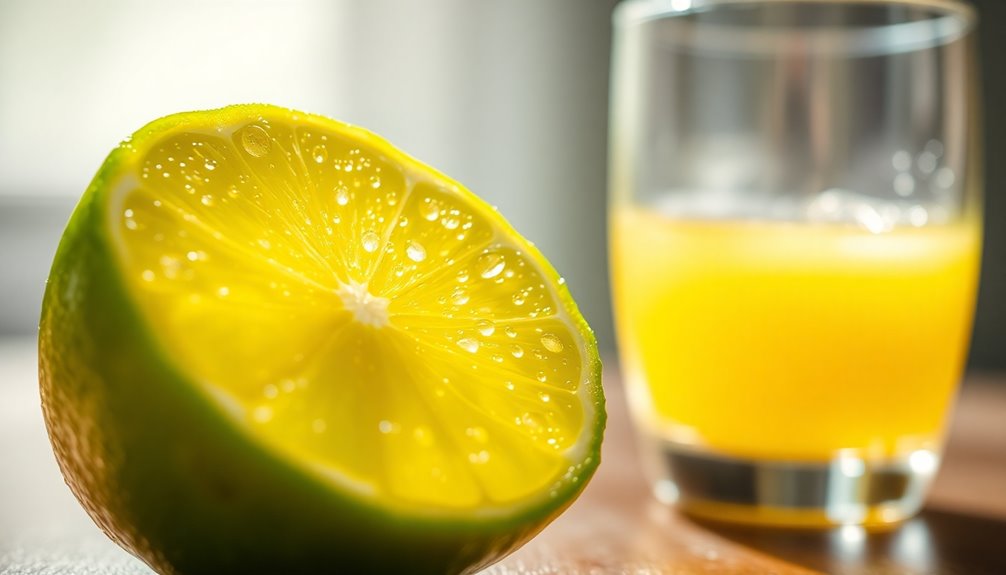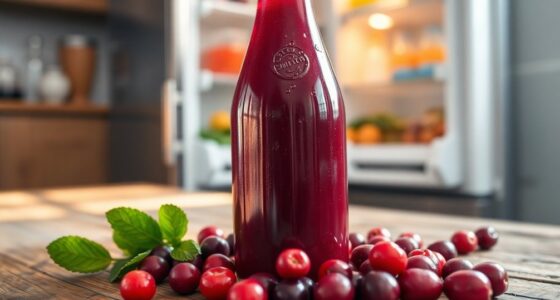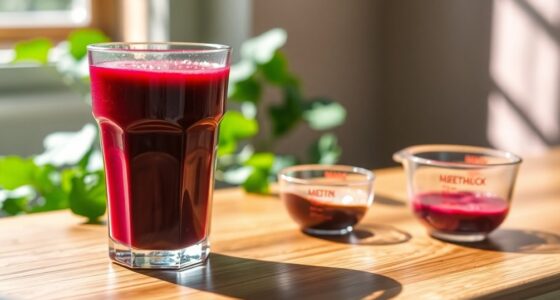A medium lime typically yields about 2 tablespoons, or 1 ounce, of juice. If you're preparing a recipe that needs more juice, like a refreshing margarita, you might need to use about 2 limes for a ¼ cup. To get the most juice, roll the lime on a cutting board before cutting. This helps break down the membranes inside. There's plenty more to explore on lime juice tips and tricks, so keep discovering!
Key Takeaways
- One medium lime typically yields about 2 tablespoons (1 ounce) of juice.
- Rolling the lime before cutting can maximize juice extraction.
- A single lime cut in half generally provides around 1 ounce of juice.
- Lime size and ripeness can affect juice yield, so have extra limes available.
- Fresh lime juice is preferred for better flavor compared to bottled juice.

When you're cooking or mixing drinks, knowing how much juice to expect from a lime can save you time and effort. Whether you're making a zesty marinade, a refreshing cocktail, or a tangy salad dressing, having the right amount of lime juice is crucial for achieving the perfect flavor balance. One medium lime typically yields about 2 tablespoons (or 1 ounce) of juice, which makes it easier to gauge how many limes you'll need for your recipes.
If you're following a recipe that calls for ¼ cup of lime juice, you'll need to grab about 2 limes. Since each lime generally gives you 2 tablespoons, that total of 4 tablespoons equals ¼ cup, so your calculations should be simple. However, sometimes the amount of juice you can extract varies based on the lime's size and ripeness, so it's always good to have an extra lime or two on hand just in case.
When you prepare to juice your limes, there's a handy little trick that can help maximize your yield. Before you slice the lime in half, roll it on your cutting board with the palm of your hand. This action helps to break down the internal membranes, allowing more juice to flow out when you cut and squeeze.
Once you've rolled it, cut the lime in half, and you should be able to squeeze out a generous amount of fresh juice with ease. Remember that a single lime cut in half will usually provide you with roughly 1 ounce of juice, or 2 tablespoons. If you're aiming for a specific amount of lime juice, keeping these measurements in mind can help streamline your cooking or cocktail-making process.
For example, if you're making a classic margarita recipe that requires the zest of fresh lime juice, knowing that you need 1 ounce means you can confidently use just one lime, while recipes demanding more can prompt you to reach for additional limes.
Limes are a popular citrus fruit, not only for their flavor but also for their versatility in a wide range of dishes and drinks. From savory to sweet, lime juice adds that tangy kick, enhancing textures and flavors.
Plus, fresh lime juice is always preferable to bottled, as it provides a more vibrant taste and aroma. So, the next time you're prepping for a meal or a fun drink, keep in mind the yield of your limes, and don't hesitate to squeeze out every bit of that delicious juice.
Frequently Asked Questions
How Much Juice Is in 1 Lime?
When you're wondering how much juice is in 1 lime, expect about 2 tablespoons or 1 ounce of fresh juice.
To get the most out of your lime, roll it on the counter before cutting; this helps release more juice.
Remember, freshly squeezed juice has a brighter flavor than bottled alternatives, making it perfect for drinks and recipes.
Can I Substitute Bottled Lime Juice for Fresh Lime Juice?
You might think that bottled lime juice can easily replace fresh lime juice, but it often falls short in flavor.
Fresh lime juice brings a bright, zesty punch that bottled options struggle to match. If you need a substitute, you can use about 1 tablespoon of bottled juice for every tablespoon of fresh, but remember to taste and adjust as needed.
For the best results, try to stick with fresh whenever you can!
How Much Real Lime Juice Equals 1 Lime?
When you're measuring lime juice, remember that one medium lime typically gives you about 2 tablespoons, or 1 ounce.
So if you're trying to figure out how much real lime juice equals one lime, you'll want to keep that in mind.
If a recipe calls for more juice, just multiply the amount needed by the number of limes you'll need, making it easy to adapt to your cooking or cocktail needs.
How Much Lime Juice Concentrate for 1 Lime?
If you're seeking a simple substitute, stick with lime juice concentrate! For one lime, you'll need about 1 ounce of concentrate, which packs a punch.
Since concentrated juice's flavor is more intense, adjust to taste to ensure your dish delights your palate.
Remember, some brands might differ in acidity, so it's smart to sample a splash before committing.
Enjoy experimenting with this zesty zing in your recipes!
Conclusion
In conclusion, you can expect to get about 2 tablespoons of lime juice from one medium-sized lime. This fresh juice can elevate your dishes, like a zesty lime vinaigrette for a summer salad. Imagine tossing together crisp greens with lime juice, olive oil, and a sprinkle of salt—it'll awaken your taste buds and make your meal unforgettable. So next time you're cooking, grab that lime and squeeze out all that delicious goodness!
Cindy thoroughly researches juicing trends, techniques, and recipes to provide readers with practical advice and inspiration. Her writing style is accessible, engaging, and designed to make complex concepts easy to understand. Cindy’s dedication to promoting the advantages of juicing shines through her work, empowering readers to make positive changes in their lives through the simple act of juicing.

















